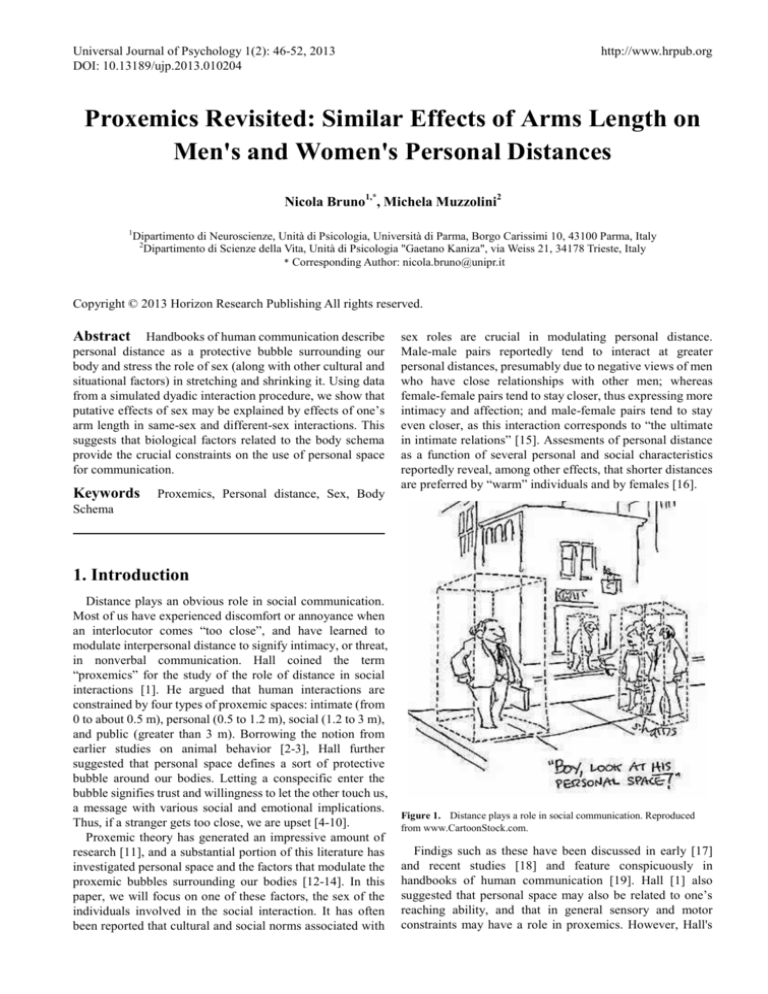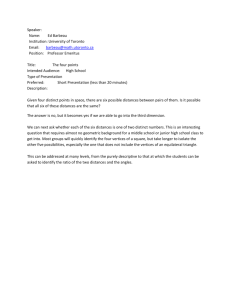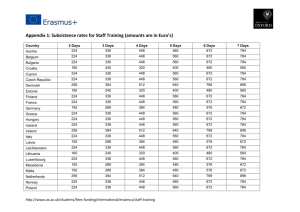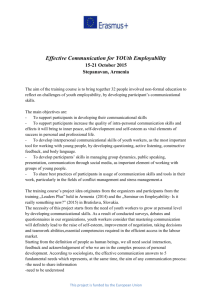
Universal Journal of Psychology 1(2): 46-52, 2013
DOI: 10.13189/ujp.2013.010204
http://www.hrpub.org
Proxemics Revisited: Similar Effects of Arms Length on
Men's and Women's Personal Distances
Nicola Bruno1,*, Michela Muzzolini2
1
Dipartimento di Neuroscienze, Unità di Psicologia, Università di Parma, Borgo Carissimi 10, 43100 Parma, Italy
2
Dipartimento di Scienze della Vita, Unità di Psicologia "Gaetano Kaniza", via Weiss 21, 34178 Trieste, Italy
﹡Corresponding Author: nicola.bruno@unipr.it
Copyright © 2013 Horizon Research Publishing All rights reserved.
Abstract Handbooks of human communication describe
personal distance as a protective bubble surrounding our
body and stress the role of sex (along with other cultural and
situational factors) in stretching and shrinking it. Using data
from a simulated dyadic interaction procedure, we show that
putative effects of sex may be explained by effects of one’s
arm length in same-sex and different-sex interactions. This
suggests that biological factors related to the body schema
provide the crucial constraints on the use of personal space
for communication.
Keywords
Schema
Proxemics, Personal distance, Sex, Body
sex roles are crucial in modulating personal distance.
Male-male pairs reportedly tend to interact at greater
personal distances, presumably due to negative views of men
who have close relationships with other men; whereas
female-female pairs tend to stay closer, thus expressing more
intimacy and affection; and male-female pairs tend to stay
even closer, as this interaction corresponds to “the ultimate
in intimate relations” [15]. Assesments of personal distance
as a function of several personal and social characteristics
reportedly reveal, among other effects, that shorter distances
are preferred by “warm” individuals and by females [16].
1. Introduction
Distance plays an obvious role in social communication.
Most of us have experienced discomfort or annoyance when
an interlocutor comes “too close”, and have learned to
modulate interpersonal distance to signify intimacy, or threat,
in nonverbal communication. Hall coined the term
“proxemics” for the study of the role of distance in social
interactions [1]. He argued that human interactions are
constrained by four types of proxemic spaces: intimate (from
0 to about 0.5 m), personal (0.5 to 1.2 m), social (1.2 to 3 m),
and public (greater than 3 m). Borrowing the notion from
earlier studies on animal behavior [2-3], Hall further
suggested that personal space defines a sort of protective
bubble around our bodies. Letting a conspecific enter the
bubble signifies trust and willingness to let the other touch us,
a message with various social and emotional implications.
Thus, if a stranger gets too close, we are upset [4-10].
Proxemic theory has generated an impressive amount of
research [11], and a substantial portion of this literature has
investigated personal space and the factors that modulate the
proxemic bubbles surrounding our bodies [12-14]. In this
paper, we will focus on one of these factors, the sex of the
individuals involved in the social interaction. It has often
been reported that cultural and social norms associated with
Figure 1. Distance plays a role in social communication. Reproduced
from www.CartoonStock.com.
Findigs such as these have been discussed in early [17]
and recent studies [18] and feature conspicuously in
handbooks of human communication [19]. Hall [1] also
suggested that personal space may also be related to one’s
reaching ability, and that in general sensory and motor
constraints may have a role in proxemics. However, Hall's
Universal Journal of Psychology 1(2): 46-52, 2013
work remained ambiguous concerning the relative
contributions of basic biological factors in defining proxemic
distances [20-21] and later investigations have largely
neglected the issue. This is surprising, as the widely reported
sex difference could in principle be explained by the notion
that personal space is related to our body’s possibilities for
action.
The concept of a “body schema” has long been used in the
neuroscience literature to refer to the set of internal
representations concerning one’s body parts and movements
[22-24]. Numerous studies have suggested that body
schema-related factors, such as possibilities for grasping and
reaching, can affect the representation of peripersonal space
[25-26]. In particular, it appears that the transition between
peripersonal (“near”) space and more distant space is
specifically related to arm length: individuals with longer
arms show a more gradual shift in spatial biases with
increasing distance than those with shorter arms [27]. Now
assume that body schemas encompassing wider spans (i.e, of
taller people having longer arms) imply larger proxemic
personal bubbles. Then one would expect to observe that
most women stand closer than most men; but not for reasons
related to sex roles. One would tend to make such
observation simply because men, on the average, have longer
arms. To our knowledge, no published investigation has
sought to assess the effect of body size on proxemic personal
space.
Figure 2. Spatial layout for the simulated dyadic interactions in the
current study. Predetermined paths were taped on the ground. Participants
mantained fixation straight ahead.
In the present paper, we seek to determine to what extent
sex differences in proxemic distances during dyadic
interactions could be accounted for by differences in arm
length. Our approach is based on a single assumption,
namely, that most of us experience discomfort when
personal space is invaded, and can report it. Thus, we set up a
standardized procedure whereby a confederate enters an
experimental participant’s personal space, and the job of the
participant is to simply to report when he or she feels uneasy.
Variations of this “stop distance” paradigm have often been
used to obtain measures related to personal space [14, 28].
We set up our own version to include different sex pairs as
well as some variation of situational factors while controlling
familiarity, and collected estimates of stop distances together
47
with measures of the participants’ arm lengths. If proxemic
theory as generally presented in handbooks of human
communication is correct, proxemic distances should change
as a function of sex quite independently of people’s size.
Alternatively, if arm length is crucial, proxemic distances
should be modulated by this factor independently of the
participant’s sex.
This is indeed what we found, with an evolutionary twist.
In same-sex interactions, personal distance was modulated
by arms length, independently of sex. The longer the arms of
the participant, the larger the distance in both men and
women. In different-sex interactions, however, personal
distance was modulated by the similarity of participant and
confederate arm length. Both men and women participants
kept at closer distances when their arms were more similar to
their confederate’s arms, and at longer distances when they
were more different. We suggest that these effects may
reflect biologically-constrained tendencies to modulate
space according to two adaptive principles: i) in members of
the same sex, arm length modulates personal space in
accordo with possibilities for action; ii) in members of
different sexes, with behavior related to accepting, or
rejecting, intimacy.
2. Materials and Methods
2.1. Participants and Design
We tested a total of 124 University of Trieste psychology
students, equally split between female and males, who
participated for course credit. None were foreign students.
Their age range was 19 - 27 years with an average of 23.4
years. All were tested individually. In addition, two
confederates participated in the study, one male and one
female. Confederates were both 24 years old and were
selected to minimize the probability that some of the
participants knew them or had seen them before. In addition,
the height of confederates was approximately equal to the
average height of female and male participants, respectively.
Participants and confederates were paired into four, equally
sized groups: female-female, male-male, female with male
confederate, male with female confederate.
2.2. Materials and Procedure
Tests were performed in a large open courtyard beneath a
University of Trieste building or in a relatively large room
(approximately 40 square meters) with no furniture. In both
cases, three white adhesive strips, 5 meters long, were laid
out on the ground to mark predetermined walking paths (see
Figure 1). Participants stood at the meeting point of the strips
and had to face straight ahead throughout the experiment.
Confederates fixated the participants on the face and walked
either forwards (personal space intrusion) or backwards
(extrusion) following the predetermined paths. Instructions
stressed that confederates should walk naturally at a steady
48
Proxemics Revisited: Similar Effects of Arms Length on Men's and Women's Personal Distances
pace and not too fast. Depending on walking direction,
participants indicated the distance at which they started to
feel discomfort or ceased to feel it. This report was provided
by simply uttering the word “stop”. As soon as the
confederate stopped, the experimenter measured the distance
from the centers of the confederate’s and the participant’s
facing midsections with a semi-rigid windup meter tape,
taking care to keep the meter horizontal.
Each participant contributed a total of 12 measures of
personal distance, resulting from the factorial combination of
2 repetitions, 2 walking directions, and 3 predetermined
paths. The order of presentation of each trial was completely
randomized within each participant. Before beginning
measurements, the experimenter demonstrated the task with
the confederate and explained that the study aimed at
measuring distances whereby participants might feel
discomfort. After the experiment, the experimenter recorded
the participant’s heights and arm length from shoulder to
wrist. Finally, she asked two additional questions: “Overall,
did you feel discomfort when the confederate was close:
definitely, some, or not at all?” and “On a 1- 7 scale, how
familiar would you say the confederate was to you (1,
complete stranger; 7, very familiar)?” and recorded the
answers. Finally, participants that so desidered were briefed
to the aims of the study and given a certificate for partial
credit.
3. Results
3.1. Data Validation
To check for transcription errors or other potential
problems in the recorded distances, we examined the
histogram portraying the distribution of this variable. This
distribution proved asymmetrical with a slight right tail
(skewness = 1.27) and a somewhat narrow central hump
(kurtosis = 3.3). The five-number summary of the
distribution was as follows: minimum = 6 cm; first quartile =
36 cm; median = 60 cm; third quartile = 87 cm; maximum =
310 cm. Despite this wide range in results, no datapoint
appeared as an obvious outlier on the histogram. For this
reason, none was excluded from the analysis at this stage
(but see section on Individual differences below). To check
for errors in the recorded biometric variables, we plotted arm
length as a function of height and inspected the bivariate
distribution. As expected, these two variables were highly
correlated, r = 0.87, and approximately normally distributed.
Inspecting the scatterplot revealed one woman participant
that was 151 cm tall but reportedly had arms that were 62 cm
long (a typical arm length for a man 180 cm tall). Given that
this was obviously a transcription error, we dropped this
datapoint and run an additional female participant to
substitute it.
3.2. Familiarity
Although confederates were chosen to minimize the
probability that participants had seen them before, this
possibility cannot be ruled out a priori. To evaluate the
possibility of familiarity relations between participants and
confederates, we inspected the frequency distribution of the
familiarity scores as recorded from the relevant final
question. For essentially all participants, these scores were
either 1 (122 cases) or 2 (11), indicating no familiarity with
the confederates. The one remaining case scored a 3,
indicating some weak degree of familiarity. We also noted
that the average distance in the 111 cases who declared the
candidates total strangers (score = 1) turned out to be 66 cm
± 1 cm, whereas the average in the other 12 cases (scores = 2,
3) was slighly less than 62 cm ± 3 cm. (Here and elsewhere,
averages are reported along with their standard errors.)
Although this difference is hard to evaluate given the lack
of precision in the second estimate, it is nonetheless
suggestive that even a very small difference as that
characterizing the change from defining someone a total
stranger to declaring some very weak degree of familiarity
appears to bring down the average personal distance
somewhat. At least qualitatively, therefore, this outcome is
in keeping with previous reports of familiarity effects on
personal distance [29]. Given the distribution of the scores
and the variability in the distances, however, we concluded
that in our study familiarity with the confederates was
essentially constant and therefore excluded it from further
analysis.
Table 1. Distribution of answers to the question: “Overall, did you feel
discomfort when the confederate was close: definitely, some, or not at all?”
and associated average distances at which participants stopped the
confederates.
answer
cases
average (cm)
SE (cm)
definitely
95
77.9
1
some
11
34.18
1.3
not at all
18
20
0.5
3.3. Individual Differences in Discomfort
Although feelings of discomfort or embarassment after
invasion of our personal space are commonly reported, it is
to be expected that a degree of individual variability exists in
the sensitivity to such phenomena. To evaluate the
importance of such potential variability and its impact on
personal distances in our procedure, we examined the
frequency distribution of the answers to the relevant final
question. As shown in Table 1, the large majority of
participants reported discomfort, but a substantial minory did
not or did to a reduced degree. These self reports turned out
very predictive of personal distances as recorded in our
simulated procedure: individuals who did not experience
discomfort or did to a lesser degree let confederates come
much closer than individuals that did. Given that participants
were naïve to the hypotheses and had no information about
our expectations about “correct” distances, these results
Universal Journal of Psychology 1(2): 46-52, 2013
provide concurrent validation to the procedure used here to
assess distance causing discomfort. Whatever the reason for
these individual differences, the crucial point here is that
only individuals actually experiencing the phenomenon of
interest can provide useful information to test our hypotheses.
For this reason, all additional analyses were perfomed on
these individuals only.
3.4. Situational Effects
Measures of personal distance were taken under different
conditions. Specifically, about one third of participants was
tested in an open courtyard, the remaining two thirds in a
closed room. In addition, each participant reported distances
along his or her line of sight, with the conferedate in the
central visual field, or along paths that were off to the right or
left by 45 degrees, placing the confederate in the peripheral
visual field. Finally, half of the reported distances pertained
to trials whereby the confederate approached the participant
(intrusion trials), whereas the other half on trials whereby he
or she receded walking backwards (extrusion). All these
variations may entail differences in reported distances that
are not of interest for the present purposes, but that may need
to be controlled statistically. To evaluate this, we computed
average distances as a function of the relevant levels of these
three variables. As stated in the previous section, here and in
all remaining analyses only participants reporting discomfort
were included. The results indicated that average personal
distances were generally smaller in the outdoor setting (72.1
cm ± 1.9 cm) than in the closed room (79.8 cm ± 1.3 cm) and
in intrusion (70.4 cm ± 1.6 cm) than in extrusion trials (85.4
cm ± 1.3 cm). In addition, average distances were larger
when the confederate was in the central visual field (85.3 cm
± 2.2 cm) than when he or she was in the periphery (74 cm ±
1.6 cm, both on the left and on the right path). Whatever their
casuses, these results indicate that variations in situational
factors do indeed modulate reported personal distances, and
will need to be taken into account in statistical evaluations of
the variables that are the object of the current study.
3.5. Effect of Participant-confederate Pair
According to proxemic theory, personal distance in dyadic
interactions should vary as a function of the sex of the
involved individuals. In particular, within the proxemics
framework man-man pairs are expected to prefer larger
distances than woman-woman pairs, and mixed pairs to
prefer the smallest distance of all (Evans & Howard, 1973).
To test this prediction, we computed the average personal
distances in the four types of interactions occurring in our
procedure: both participant and confederate male, both
female, male participant with female confederate, and female
participant with male confederate. Table 2 presents the
results: as expected by proxemic theory, we observed larger
distances in male-male than female-female pairs, and the
smallest distances in pairs whereby the participant was male
and the confederate female. In contrast with proxemic theory,
49
however, in the other kind of mixed pair the average distance
was larger than that for female-female pairs. We will not
discuss further these results here as we believe that the
crucial variable is in fact not the sex of either individual, but
arm length (see following section).
Table 2. Average distances at which participants stopped the confederates
as a function of their respective sexes.
pair
cases
average (cm)
SE (cm)
female-female
25
70.7
1.5
male-female
20
67.6
2.2
female-male
23
79.5
2.3
male-male
27
90.7
0.5
3.6. Effect of Arm Length
As argued in the introduction, one reason for differences
in chosen personal distances between men and women may
be that men have, on the average, longer arms than women.
To evaluate this possibility, we plotted results from all trials
against the length of the participant’s arms, after
color-coding the datapoints according to the type of
participant-confederate pair (see Figure 2). This plot
revealed a large variability in chosen distances, as one would
expect given the differences due to the situational factors
examined above. Importantly for our present purposes,
however, the plot also indicated that chosen distances were
modulated by the length of the participant’s arm.
Consider same-sex interactions first. Strikingly, in both
same-sex groups the scaling of distance with arm length (as
measured by the slope of least-squares regression line)
amounts to an increase of about 3-4 cm in personal distance
for each additional cm in arm length. When the male and
female groups are placed on the same graph, as we have done
in Figure 3, the corresponding regression fits are almost
perfectly collinear, and they would largely coincide with the
single regression line fitted to the two groups as a whole, had
we placed it on the graph. These results indicate that, in
same-sex pairs, variations in stop distances can be ascribed
to differences in arm length between the participants rather
than their sex: the average difference between distances in
the two groups is simply due to the fact that male generally
have longer arms, such that the corresponding data are
displaced to the right of the graph.
Now consider different-sex interactions. In this case, the
fitted lines are clearly not collinear. In fact, they seem to
reveal opposite effects of arm length: when the participant
was female and the confederate was male, distances decrease
with the female participant’s arm length, whereas they
increase in the other group. However, another feature of our
data suggests that arm length remains crucially involved in
modulating the effect. Recall that confederates were chosen
to have approximately average heights (and therefore arm
lengths) for their corresponding groups. This entails that, in
different-sex pairs, the male confederate was always taller
50
Proxemics Revisited: Similar Effects of Arms Length on Men's and Women's Personal Distances
(and had longer arms) than any female participant, whereas
the female confederate was always shorter (and had shorter
arms) than any male participant (see also arrows on top of
Figure 3). This feature of the data suggests that, in
different-sex pairs, distances did not increase as a function of
the participant’s arm length, but of the (unsigned) difference
between the arm lengths of the participant and the
confederate. Shorter female participants were more different
than the male confederate and, other things being equal, kept
him at a greater distance than taller female participants.
Conversely, taller male participants were more different than
the female confederate, and kepth her at a greater distance
than shorter male participants.
confederate direction and position, were modelled as fixed
effect varying within participants. To provide appropriate
denominators for testing within-factor effects, we also
included in the model the appropriate two-way interactions
with the participant factors. Finally, to compare the roles of
the arm length-related and sex factors, we also entered into
each analysis the participant’s sex as a fourth categorical
variable.
3.7.1. Same-sex Model
Overall, the model accounted for about 70% of the total
variance. The following factors were statistically significant:
arm length, F (1, 416) = 13.3, p ≤ 0.0003, starting position, F
(2, 102) = 17.0, p ≤ 0.0001, direction of approach, F (2, 51) =
36.9, p ≤ 0.0001, and place of testing, F (1, 416) = 5.9, p ≤
0.02. Participant sex failed to reach significance, F(1, 416) =
2.8, p > 0.09.
3.7.2. Different-sex Model
Overall, this second model accounted for about 86% of the
total variance, this time with all factors statistically
significant: difference between participant’s and
confederate’s arm lengths, F (1, 344) = 93.2, p ≤ 0.0001,
starting position, F (2, 102) = 17.0, p ≤ 0.0001, direction of
approach, F (2, 51) = 36.9, p ≤ 0.0001, place of testing, F (1,
416) = 5.9, p ≤ 0.02, and sex, F (1, 344) = 70, p ≤ 0.0001.
Figure 3. Chosen personal distance, as operationalized by distances
whereby participants asked confederates to stop, as a function of participant
arm length, in four different types of dyadic interactions. Arrows on top of
the panel indicate arm lengths for the female and male confederate.
3.7. Modelling Factors That Affect Distance
The preliminary analyses performed in the preceding
sections suggests that factors affecting distance in personal
space should be described by taking into account a variety of
predictors, including individual differences and various
categorical factors such as the place of testing (indoors or
outdoors), the direction of the confederate movement
(intrusion or extrusion), and the confederate position relative
to the participant line of sight (central visual field, or
peripheral to the left or right). In addition, and most
importantly, it suggests that the variability in chosen
distances is modulated by arm length in different ways for
the same-sex and different-sex pairs. Given this structure in
the data, to subject the present data to inferential analysis we
fitted two separate linear models (ANCOVA) to the
same-sex and different-sex data, including two different
quantitative covariates: in the same-sex data, we entered into
the analysis the length of the participant’s arm, whereas in
the different-sex data we entered the absolute difference
between the participant and the confederate arm lengths.
Quantitative variables related to arm length were modelled
as random effects varying between participants. Place of
testing was modelled as a fixed effect also varying between
participants. The other two categorical predictors,
4. Discussion
At least in simulated dyadic interactions such as those
studied here, there is little support for the claim that sex, per
se, is a factor in modulating personal distance as claimed by
standard proxemics textbooks. The present pattern of results
suggests instead that an important difference exists in the use
of personal sapce between pairs of individuals of the same
sex and of different sexes. When other factors that affect
distance are taken into account, individuals tend to keep
conspecifics of the same sex at a distance inversely
proportional to their arm length, whereas they tend to keep
conspecifics of a different sex at a distance inversely
proportional to the degree of similarity between their body
sizes: a man will let a woman with approximately equal long
arms come closer than a smaller woman, and vice-versa.
While these results suggest that factors related to the body
schema may account for effects that are widely reported as
due to sex roles, they do not necessarily imply that all social
and cultural factors are irrelevant to our understanding of
personal distance. In the different-sex condition of the
current study, for instance, along with a modulating effect of
differences in arm length we did observe a (somewhat
smaller) effect of participant sex: arm length differences
being equal, male participants tended to let the female
confederate come closer than did female participants with
the male confederate. This difference is very likely to be
related to different social norms and stereotypes regarding
appropriate behaviors for male or females encountering
Universal Journal of Psychology 1(2): 46-52, 2013
51
members of the opposite sex.
In addition, the proxemics literature is rich in studies
documenting the role of ethnicity in modulating proxemic
distance. A recent study [30], for instance, measured spaces
between 23 seated participants that were filling mock
questionnaires. Results showed that Anglo Saxons sat at the
largest distance, whereas Mediterraneans and Latinos
preferrred shorter distances. This finding is consistent with
earlier results [31-33]. Although we did avoid recruiting
foreign students as participants, we did not control for
participant’s family region of origin. This is unlikely to
explain our results as participants were assigned randomly to
conditions. However, region of origin may account for part
of our observed variability due to differences in cultural
norms for personal space in, for instance, Southern and
Northern Italians. It may also be noted, however, that at least
some of the reported ethnicity effects may involve also a
contribution from factors related to the body schema. Latinos
and Mediterraneans also tend, on the average, to be
somewhat shorter than Anglo Saxons or Scandinavians, as
do Southern compared to Northern Italians.
anthropological contexts. It suggests that handbook accounts
of the role of distance in human interactions need revision, at
least in their current emphasis on the role of the sex of the
interacting individuals. It also calls for reinvesigations of
reported sociocultural factors. We suggest that, to these aims,
the neuroscience of cognitive representations of the body [34]
and of environmental constraints on different types of
perceptual [35] and neuropsychological [36] space proves a
source of useful insights and directions for clarifying how
differences related to sex interact with body-related factors
[37].
5. Conclusion
REFERENCES
The present results demonstrate that arm lenght modulates
personal distance whereas sex plays only an indirect role in
defining such distance. In same-sex pairs, in particular, the
seeming difference between male and female pairs can be
entirely explained by the effect of arm length in both men
and women. Such an effect may reflect a role of action
potentiality in modulating personal space: if you approach
me, I keep you at a distance that is just-within–reach, but no
closer. In different-sex pairs, the interpretation of the results
is more complex. We propose that in this case the different
effect of arm length in female-male vs. male-female pairs
might reflect not only generic possibilities for action, but
also the possibility of accepting or rejecting intimacy. If your
body size resembles mine (such that our arms are similar in
lenght), I am more likely to let you come closer. As an
alternative, the pattern of results in the different-sex pairs
could be interpreted as reflecting different social norms for
males and females as they are approached by different-sex
individuals. When men are approached by women, letting
the woman come closer does not carry a negative
connotation for the man. When female are approached by a
strange man, conversely, there may be a tendency for the
woman to keep the man farther away to avoid culturally
negative implications. Within this alternative account, it is
less clear however why these culturally-induced biases
would produce opposite slopes as a function of arm length.
Whatever the case, the results seem at odds with the
prediction of standard proxemic theory.
The possibility that factors related one’s body size play a
role in setting the limits of the proxemic bubble of personal
distance should be of interest to students of human
communication in psychological, sociological, and
[1]
E. T. Hall. The hidden dimension. New York: Doubleday,
1966.
[2]
H. Hediger. Studies of the psychology and behaviour of
captive animals in zoos and circuses. Butterworths Scientific
Publications, 1955.
[3]
J. von Uexküll. A Stroll Through the Worlds of Animals and
Men: A Picture Book of Invisible Worlds. In C.H. Schiller (a
cura di) Instinctive Behavior: The Development of a Modern
Concept. New York: International Universities Press, Inc.,
1957.
[4]
M. Argyle. Bodily communication. New York: International
Universities, 1975.
[5]
J.K. Burgoon, J. L. Hale. Nonverbal expectancy violations:
model elaboration and application to immediacy behavior.
Communication monographs, 55, 58-79, 1988.
[6]
M.A. Dosey, M. Meisels. Personal space and self-protection.
Journal of Personality and Social Psychology, 11, 93-97,
1969.
[7]
N. Felipe, R. Sommer. Invasions of personal space. Social
Problems, 14, 206-214, 1966.
[8]
R. Sommer.. Personal space: the behavioral basis of design.
Prentice-Hall, Englewood Cliffs, 1969.
[9]
R. D. Middlemist, E. S.Knowles, C.F. Matter. Personal space
invasions in the lavatory: suggestive evidence for arousal. J
Pers Soc Psychol, 33(5), 541-46, 1976.
Acknowledgements
Based in part on Michela Muzzolini’s master thesis at the
University of Trieste. The authors thank Dr. Stefano
Ghirlanda for useful comments on an earlier version of this
manuscript. This work was supported in part from a start-up
grant from the University of Parma.
[10] D. P. Kennedy, J. Glascher, J.M. Tyszka, R. Adolphs.
Personal space regulation by the human amygdala. Nature
Neuroscience, 12(10), 1226-1227, 2009.
[11] J.R. Aiello. Human Spatial Behavior. In D. Stokols and I.
Altman (eds), Handbook of Environmental Psychology Vol 1,
52
Proxemics Revisited: Similar Effects of Arms Length on Men's and Women's Personal Distances
New York: Wiley, 1987.
[12] L.A. Hayduk. Personal space: An evaluative and orienting
overview. Psychological Bulletin, 85, 117-134, 1978.
cognition: evidence from visual neglect. Trends Cogn Sci
7:125–133, 2003.
[13] L.A. Hayduk. Personal space: Where we now stand.
Psychological Bulletin, 94, 293-335, 1983.
[26] G. Rizzolatti C.Scandolara, M. Matelli, M. Gentilucci.
Afferent properties of periarcuate neurons in macaque
monkeys. II. Visual properties. Behav Brain Res 2:147–163,
1981.
[14] L.A. Hayduk. The shape of personal space: an experimental
investigation. Canadian Journal of Behavioral Science, 13,
274-87, 1981.
[27] M. R. Longo, S. F. Lourenco (2007). Space perception and
body morphology: extent of near space scales with arm length.
Exp Brain Res, 177(2), 285-90, 2007.
[15] G.W. Evans, R.B. Howard. Personal space. Psychological
Bulletin, 60, 334-344, 1973.
[28] L. Adams, D. Zuckerman (1991). The effect of lighting
conditions on personal space requirements. The journal of
general psychology, 118, 335-40, 1991.
[16] R. Gifford. Projected interpersonal distance and orientation
choices: Personality, sex, and social situation. Social
Psychology Quarterly, 45, 142-152, 1982.
[17] J.J. Hartnett, K.G. Bailey, F.W.J. Gibson. Personal space as
influenced by sex and type of movement. Journal of
Psychology, 76(2d Half), 139-44, 1970.
[18] D. Uzzell, N. Horne,. The influence of biological sex,
sexuality and gender role on interpersonal distance. British
Journal of Social Psychology 45(Pt 3), 579-97, 2006.
[19] J.A. DeVito. Human Communication. Boston: Allyn &
Bacon., 2002.
[20] M. Baldassare, S. Feller. Cultural variations in personal space:
Theory, methods, and evidence. Ethos, 3, 481-503., 1975.
[21] E. Griffin, E. A first look at communication theory. New
York: McGraw-Hill, 1991.
[22] G. Berlucchi, S.M. Aglioti. The body in the brain: neural
bases of corporeal awareness. Trends in Neurosciences,
20(12), 560-64, 1997.
[23] M.R. Longo, P. Haggard. What is it like to have a body?
Current Directions in Psychological Science, 21(2), 140-45,
2012.
[24] N. Holmes, C. Spence. Beyond the body schema: Visual,
Prosthetic and Technological Contributions to Bodily
Perception and Awareness. In G. Knoblich, I. M. Thornton, M.
Grosjean & M. Shiffrar, Human body perception from the
inside out. New York, NY: Oxford University press, 14-64,
2006.
[25] P.W. Halligan G.R. Fink , J.C.Marshall , G.Vallar G. Spatial
[29] L.N. Ashton, M.E. Shaw, A. P. Worsham, Affective reactions
to interpersonal distance by friends and strangers. Bulletin of
the Psychonomic Society, 15: 306-308, 1980.
[30] C. M. J. Beaulieu. Intercultural study of personal space: A
case study. Journal of Applied Social Psychology, 34,
794-805, 2004.
[31] C. Albas, D. Albas. Aligning actions: the case of subcultural
proxemics. Canadian Ethnic Studies, 21, 74-82., 1989.
[32] D. Thompson, J. Baxter. Interpersonal distance spacing in
two-person cross-cultural interactions. Man-Environment
Systems, 3, 115-117, 1973.
[33] S. Li. How close is too close? A comparison of proxemic
reactions of Singaporean Chinese to male intruders of four
ethnicities. Perceptual and Motor Skills, 93(1), 124-26, 2001.
[34] H. De Preester, V. Knockaert. Body Image and Body Schema.
Amsterdam: John Benjamins Publishing, 2005.
[35] J.E. Cutting, P.M. Vishton. Perceiving layout and knowing
distances: The interaction, relative potency, and contextual
use of different information about depth. In W. Epstein & S.
Rogers (Eds.) Perception of space and motion. (pp. 69-117).
San Diego, CA: Academic Press, 1995.
[36] F. H. Previc. The neuropsychology of 3-D space.
Psychological Bulletin, 124, 123-164, 1988.
[37] H. Stancey, M. Turner. Close women, distant men: line
bisection reveals sex-dimorphic patterns of visuomotor
performance in near and far space. British Journal of
Psychology, 101(Pt 2), 293-309, 2010.









